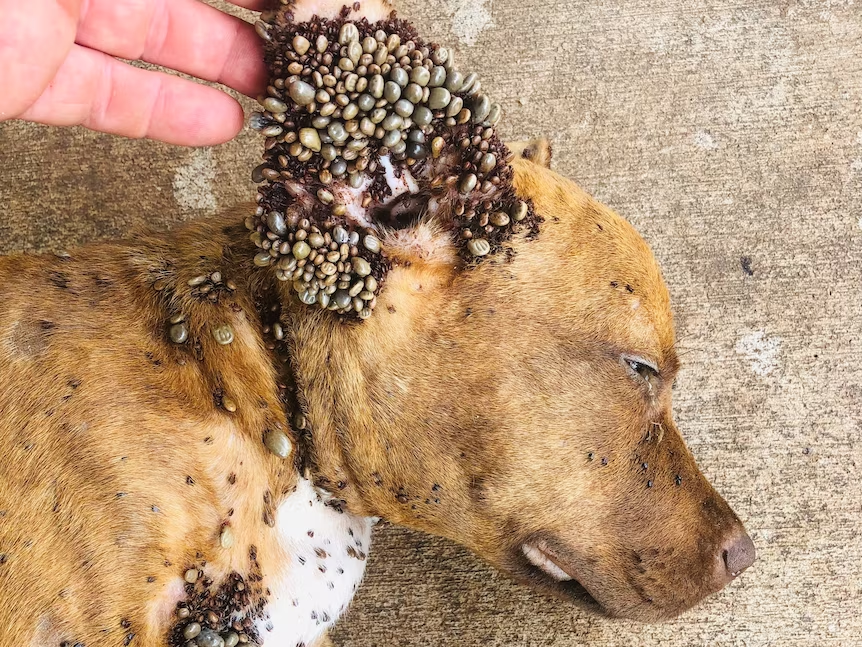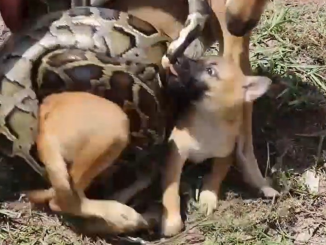The two-year-old dog became lethargic, thin and listless, deteriorating to the point that it was admitted to a pet hospital for a week for a blood transfusion.
“I was really worried about him,” Ms Powell, an enrolled nurse, said.
Testing confirmed Leo had ehrlichiosis, a disease transmitted through bites from brown dog ticks carrying the Ehrlichia canis bacteria.
But what worried the specialists is that Leo lives in the urban Top End, which some experts fear is becoming a new stronghold for a disease spreading like wildfire.
The first Australian case was detected in the Kimberley region of Western Australia in May last year.
By June, cases were rapidly emerging in Katherine in the Northern Territory and the surrounding remote communities.
The Northern Territory government has recorded 370 confirmed cases — 110 in the Darwin and Arnhem Land region, 149 in the Katherine region, 36 in Tennant Creek and in Alice Springs and surrounds, 75.
Experts say countless more have been left undetected in remote communities with little intervention.
“When we finally got to bring him home, [the vets] said he needs to stay inside, he’s at risk of spontaneous bleeding and he might not make it,” Ms Powell said.
“It was very full-on, very emotional.
“There were tears basically every night.”
Until the first cases were discovered just last year, stringent biosecurity controls had kept ehrlichiosis out of Australia.
Experts are still baffled by how the disease got in but, according to Professor Peter Irwin from the School of Veterinary Medicine at Murdoch University, the disease is now considered “endemic” across the NT.
“Ehrlichiosis is one of the most serious diseases of dogs in my opinion,” he said.
“It makes them very ill, and many dogs can die.
“Once it establishes into a tick population, it’s very difficult to eradicate.”

Common symptoms include lethargy, fever and cloudy eyes, which can be cleared up with antibiotics but, if left untreated, the disease can lead to blindness, uncontrollable bleeding and death.
“The problem with this disease is that dogs travel and spread infected ticks,” Professor Irwin said.
“Dogs that have moved from an endemic area of the community into the city will possibly bring ticks with them, and the ticks can then drop off.
“There have now been dogs with the disease identified in most other capitals, most as a result of travel from the north.”
Doctor Stephen Cutter, the head veterinarian at Darwin’s Ark Animal Hospital, is no stranger to the crippling disease.
He said up to 40 per cent of the dogs are infected in the remote communities of the Top End he visits on rotation.
But in August of last year, he saw his first case in a pet that had not left urban Darwin.
Arielle Giles, a vet at the Darwin Veterinary Hospital, confirmed the disease’s spread to Darwin, saying she had seen six cases in the past three months.
“It’s a devastatingly bad disease and it’s really difficult to treat,” Dr Cutter said.
“It’s basically everywhere and it’s now a matter of living with it.”
Both Professor Irwin and Dr Cutter said keeping ticks at bay is the best way to prevent ehrlichiosis.
“Because the infection is transmitted so quickly from the tick bites, the most important way of protecting your dog is to use a product, such as a collar that kills ticks before they bite,” Professor Irwin said.
It has now been five months since Leo was struck down by the tiny parasite and, while he is still getting regular check-ups and his future is looking brighter, vets can’t give the all-clear.
“Ehrlichiosis is really nasty in that it can stay hidden in the bone marrow for a long period of time,” Dr Cutter said.
Earlier this year, the NT government brought on a new coordinator to transition the NT’s response to the disease from a biosecurity threat to managing the outbreak.
“This disease is a nationally notifiable disease, which means that suspected cases of E.canis need to be reported, and free testing can be carried out on blood samples from suspected dogs,” said the chief vet at the Department of Industry, Tourism and Trade, Dr Sue Fitzpatrick.
Heartbreaking Encounter: An Unconscious and Chained Dog’s Desperate Cry for Help on the Streets

Amidst a Tranquil Stroll: A Tale of Compassion and Rescue
One fateful Sunday evening, as I wandered through the familiar streets of São Paulo, an unexpected and heart-wrenching sight crossed my path. In the dimly lit corner of the street, I encountered a pitiful scene that shook me to my core: a defenseless dog, unconscious and chained.
Approaching cautiously, I could see the dog’s once lustrous fur now matted and soiled, a poignant testament to its prolonged suffering. The rusty chain, cruelly tight, had inflicted visible discomfort and injuries upon the poor creature’s neck.
The dog’s once-vibrant eyes, now dimmed by fear and pain, made feeble attempts to summon help with raspy, plaintive barks, yet it seemed invisible to the indifferent passersby. My heart ached witnessing this desperate cry for aid go unanswered.
Without hesitation, I knew I had to intervene. With trembling hands, I carefully examined the chain, realizing it had become embedded deep within the dog’s skin, causing severe wounds. Gently, I reached into my bag for a pair of scissors and painstakingly began to free the dog, mindful not to inflict further harm.

As the chain fell away, the dog slowly regained consciousness. Its trust in humanity had been shattered, but it tentatively accepted my reassuring touch. Tears welled in my eyes as I contemplated the cruelty it had endured.
The next steps were clear: I needed to seek immediate medical attention for this suffering soul. Cradling the dog gently in my arms, I embarked on a mission to find the nearest animal shelter or veterinary clinic capable of providing the care and rehabilitation it so urgently required.
This encounter served as a stark reminder of the paramount importance of compassion and empathy toward all living beings. It was a resounding call to action, a plea for change.
The surviving puppy found refuge with me, and I promptly alerted the relevant authorities to collect the deceased dog. According to the Samson Law, the owner of these animals will be held accountable for their actions.
Let us collectively work toward a world where such heart-wrenching encounters become rare, and compassion prevails.



Leave a Reply